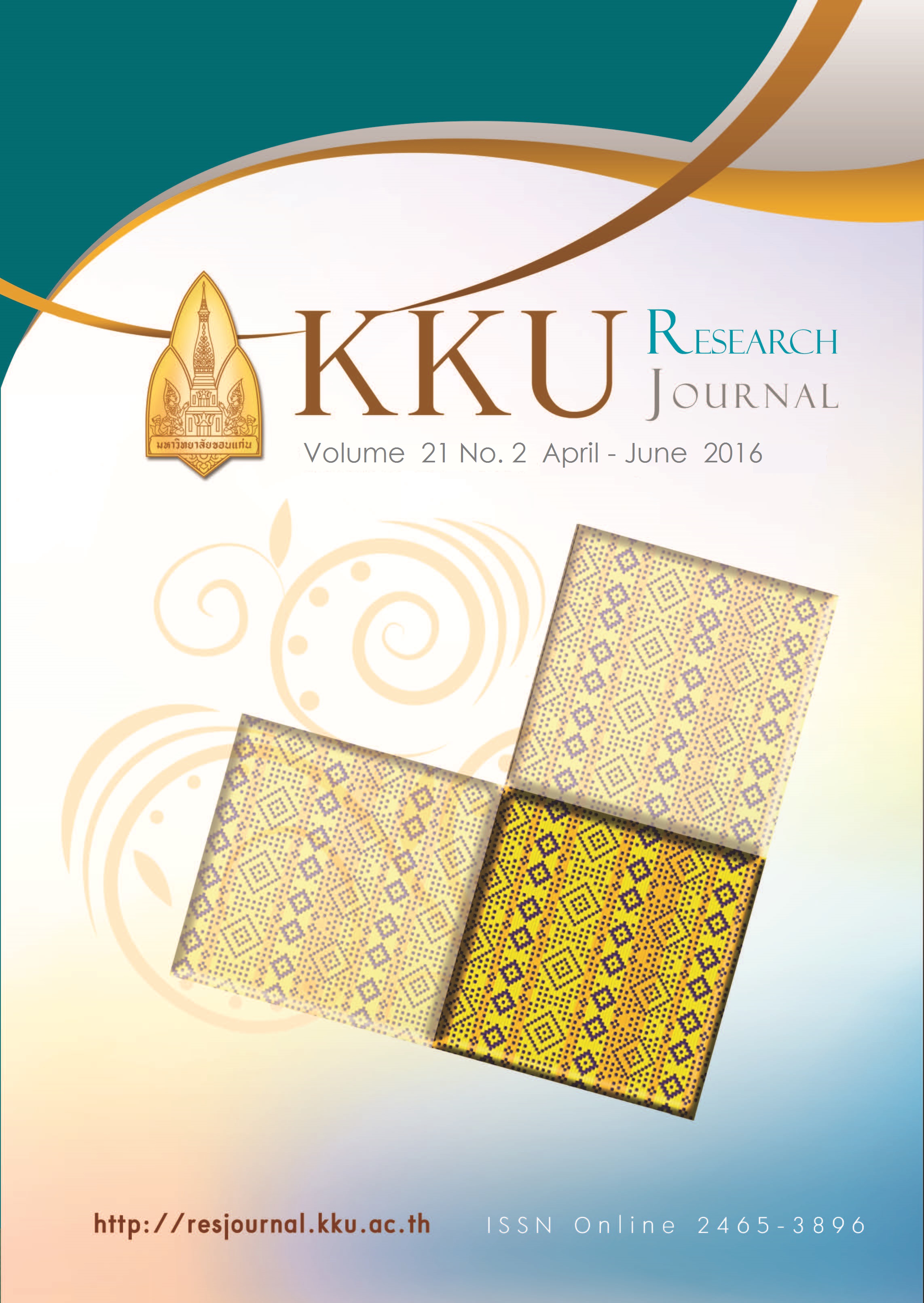Optimization of conditions for direct bio-hydrogen production from water hyacinth by clostridium diolis C32-KKU
Main Article Content
Abstract
Water hyacinth contains cellulose and hemicellulose which can be used as a substrate for bio-hydrogen production. Clostridium diolis C32-KKU, a cellulolytic bacterium, was employed to directly ferment water hyacinth to bio-hydrogen. The objective of this study was to optimize the direct bio-hydrogen production from water hyacinth by C. diolis C32-KKU. Two operation modes for bio-hydrogen production i.e. static and shaking modes were investigated. The results showed that the shaking mode was more effective than the static mode for hydrogen production. The shaking mode was then used to optimize bio-hydrogen production by variation of initial pH (4.0, 4.5, 5.0, 5.5, 6.0, 6.5, 7.0, 7.5, 8.0, 8.5 and 9.0) and initial water hyacinth concentration (5, 10, 15, 20, 25 and 30 g-dry weight (dw)/L). The maximum hydrogen production of 19 mL/L was obtained at the initial pH of 5.5 and water hyacinth concentration of 10 g-dw/L. The cellulase activity of 0.0081 unit/mL was obtained under the optimal condition. The results of this study showed that direct bio-hydrogen production from lignocellulosic materials could be feasible.
Article Details
References
[2] Su H, Cheng J, Zhou J, Song W, Cen K. Hydrogen production from water hyacinth through dark-and photo- fermentation. International Journal of Hydrogen Energy. 2010; 35(17): 8929-8937.
[3] Cheng J, Lin R, Song W, Xia A, Zhou J, Cen K. Enhancement of fermentative hydrogen production from hydrolyzed water hyacinth with activated carbon detoxification and bacteria domestication. International Journal of Hydrogen Energy. 2015; 40(6): 2545-2551.
[4] Zheng XJ, Yu HQ. Inhibitory effects of butyrate on biological hydrogen production with mixed anaerobic cultures. Journal of Environmental Management. 2005; 74(1): 65-70.
[5] Zhang H, Bruns MA, Logan BE. Biological hydrogen production by Clostridium acetobutylicum in an unsaturated flow reactor. Water Resource. 2006; 40(4): 728-30.
[6] Okeke, BC and SKC Obi. Saccharification of agro wastes materials by fungal cellulases and hemicellulases. Bioresource Technology. 1995; 5(1): 23-27.
[7] Zweitering MH, Jongenburger L, Rombouts FM, Van’t Riet K. Modelling the bacteria growth curve. Applied Environmental Microbiology. 1990; 56: 1875-1881.
[8] Tapia-Venepas E, Ramirez JE, Donoso-Bravo A, Jorquera L, Steyer JP, Ruiz-Filippi G. Bio- hydrogen production during acidogenic fermentation in a multistage stirred tank reactor. International of hydrogen energy. 2013; 38(5): 2185-2190.
[9] Qiao W, Takayanagi K, Niu Q, Shofie M, Li YY. Long-term stability of thermophilic co-digestion submerged anaerobic membrane reactor encountering high organic loading rate, persistent propionate and detectable hydrogen in biogas. Bioresource Technology. 2013; 149: 92-102.
[10] Ferchichi M, Crabbe E, Gil GH, Hintz W, Almadidy A. Influence of initial pH on hydrogen production from cheese whey. Journal of Biotechnology. 2005; 120(4): 402-9.
[11] Masset J, Hiligsmann S, Hamilton C, Beckers L, Franck F, Thonart P. Effect of pH on glucose and starch fermentation in batch and sequenced-batch mode with a recently isolated strain of hydrogen-producing Clostridium butyricum CWBI1009. International Journal of Hydrogen Energy. 2010; 35(8): 3371-3378.
[12] Loges B, Boddien A, Garten F, Junge H, Beller M. Catalytic Generation of Hydrogen from Formic acid and HS Derivatives: Useful Hydrogen Storage materials. Paper Springer Science and Business media. 2010; 53: 902-914.
[13] Setlhaku M, Brunberg, S, Villa EA, and Wichmann R. Improvement in the bioreactor specific productivity by coupling continuous reactor with repeated fed-batch reactor for acetone-butanol-ethanol production. Journal of Biotechnology. 2012; 16(2): 147-152.
[14] Fan YT, Zhang YH, Zhang SF, Hou HW, Ren BZ. Efficient conversion of wheat straw wastes into biohydrogen gas by cow dung compost. Bioresource Technology. 2006; 97(3): 500-5.
[15] Alalayah WM, Kalil MS, Kadhum AAH, Jahim JM, Alauj NM. Hydrogen production using Clostridium saccharoperbutylacetonicum N1-4 (ATCC 13564). International Journal of Hydrogen Energy. 2008; 33(24): 7392–7396.
[16] Argun H, Kargi F, Kapdan IK. Effects of the substrate and cell concentration on bio-hydrogen production from ground wheat by combined dark and photo- fermentation. International Journal of Hydrogen Energy. 2009; 34(15): 6181-6188.


